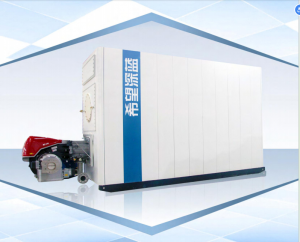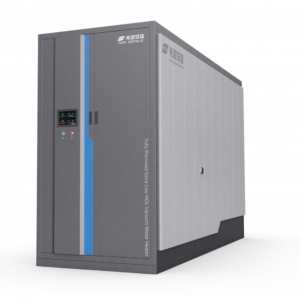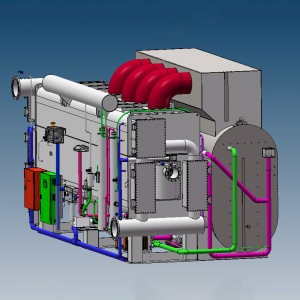
Products
Utral Low NOx Vacuum Hot Water Boiler
Central Vacuum Water Boiler
Central vacuum water boiler, also known as vacuum phase change boiler, is the use of water at different pressure, the corresponding boiling temperature of different characteristics to work. At atmospheric pressure (one atmosphere), the boiling temperature of water is 100C, while at 0.008 atmospheric pressure, the boiling temperature of water is only 4°C.
According to this characteristic of water, the vacuum hot water boiler works in the vacuum degree of 130mmHg~690mmHg and the corresponding boiling temperature of water is 56°C ~97°C. When the vacuum hot water boiler works under the working pressure, the burner heats the medium water on and makes it temperature rising to meet saturation and evaporation.
The water in the heat exchanger tubes, which are inserted boiler, become hot water by absorbing the outside heat of water vapor, then the vapor are condensed into water and be heated again, thus completing the entire heating cycle.

Low NOx Vacuum Hot Water Boiler

With the reduction of non-renewable energy sources, the rising of energy prices and increasing attention of energy conservation and environmental protection in China, Hope Deepblue has successfully developed a condensate low NOx vacuum hot water boiler, whose efficiency can reach 104%. Condensate vacuum hot water boiler adds a Exhaust condenser on standard vacuum hot water boiler to recycle the sensible heat from exhaust gas and the latent heat from water vapour, so it can reduce the Exhaust emission temperature and recycle the heat to heat the circulating water of boiler, improving efficiency of boiler evidently.
The higher vapor content in the Exhaust, the more heat is released from condensation.
● Negative pressure operation, reliable and safe
Boiler always works under a negative pressure without the risk of expansion and explosion. After installation, there is no need to be supervised and inspected by the boiler pressure organization, and there is no need to review the operation qualification.
● Phase-change heat transfer, more efficient
The unit is a wet back type water pipe structure vacuum phase change heat, heat transfer intensity is large. The thermal efficiency of the boiler is as high as 94%~104%.
● Built-in heat exchanger, multi-functions
The central vacuum water boiler can provide multiple loops and different temperatures of hot water, to meet the users' heating, domestic hot water, swimming pool heating and other hot water demands, and can also provide process water for kinds of industrial and mining enterprises. Built-in heat exchanger can support higher pipe pressure, and can supply heating hot water and domestic hot water to high-rise building directly. It is not necessary to install another heat exchanger.
● Closed circulation, longer life span
The furnace has a certain degree of vacuum and the heat medium water is soft water. The heat medium steam conduct indirect heat transferring with the hot water in built-in heat exchanger pipes, the heat medium cavity will not be scaling, the furnace body will not corrode.
● Automatic control system, easy operation
The hot water temperature can be set freely within the range of E90°C. The microcomputer PID control can automatically adjust the energy according to the heat load, to control the hot water at setting temperature. Timed on/off, no need to guard, and user can observe the current hot water temperature and other parameters.
- Multiple safety protection, operation status monitoring
The boiler sets a lot of safety protection devices, such as hot water temperature too high protection, heat medium temperature too high protection, heat medium water antifreeze protection, boiler over pressure protection, liquid level control, etc, The fault is automatically alarmed, so that the danger of overpressure and dry burning will never occur. The control system has a perfect self-test function, when there is an abnormality in the boiler, the burner automatically stops working and shows the fault point, which provides a clue for troubleshooting.
● Remote monitoring, BAC Building Control
The reserved RS485 communication interface can realize the user's demand for remote monitoring, group control and BAC control of the boiler.
● Environmental-friendly combustion, exhaust emission clean
Adopting wide furnace design, equipped with imported ultra-low NOx burner with automatic stepless regulation function makes the combustion safe, exhaust clean, and all indicators meet the most stringent national requirements, especially NOx emission≤ 30mg/Nm3.

The formation and hazards of NOx
During the combustion process of oil and gas , it produces nitrogen oxides, the main components of which are nitric oxide (NO) and nitrogen dioxide (NO2), collectively known as NOx. NO is colorless and odorless gas, insoluble in water. It accounts for more than 90% of all NOx formed during high temperature combustion, and is not highly toxic or irritating when its concentration ranges from 10-50 PPm. NO2 is brownish-red gas that is visible even at low concentrations and has a distinctive acidic odor. It is strongly corrosive and can irritate the nasal membranes and eyes at concentrations of nearly 10 ppm even only remaining a few mins in the air, and it can cause bronchitis at concentrations of up to 150 ppm and pulmonary edema at concentrations of up to 500 ppm.
The main measures to reduce NOx emission value
1. When low NOx emission are required, adopt natural gas as fuel instead of liquid or solid fuel.
2. Lower NOx emissions by increasing the size of the furnace to reduce combustion intensity
The relationship between combustion intensity and furnace size.
Combustion intensity=Burner output power[Mw]/Furnace Volume[m3]
The higher the combustion intensity in the furnace, the higher the temperature inside the furnace, which directly affects the NOx emission value. Therefore, in order to reduce the combustion intensity in the case of a certain burner output power, it is necessary to increase the furnace volume (i.e., increase the size of the furnace membrane).

3. Adopt advanced ultra-low NOx burner
1) The low NOx burner adopts electronic proportional adjustment and oxygen content control technology, which can precisely control the burner to meet the low NOx emission requirements under different working conditions.
2) Adopt ultra low NOx burner with FGR external Exhaust circulation combustion technology
FGR external Exhaust circulation combustion, from the flue to extract part of the low-temperature Exhaust and combustion air mixed in the combustion head, which reduces the oxygen concentration in the hottest flame area, slow down the combustion speed, result in a lower flame temperature. When the Exhaust reaches a certain amount of circulation, the temperature of the furnace is reduced, which suppresses the generation of NOx.












